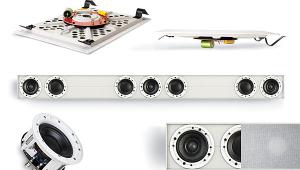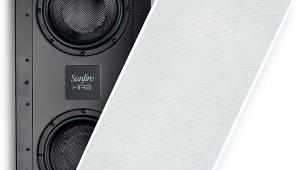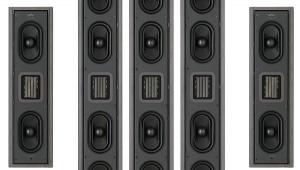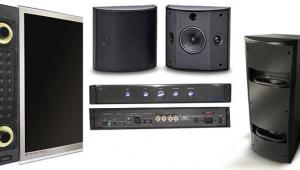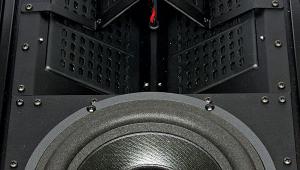Wisdom Audio Sage L100i In-Wall Speaker System
 Price: $88,500 At A Glance: A unique listening experience • Unprecedented detail and transparency • Exceedingly good bass
Price: $88,500 At A Glance: A unique listening experience • Unprecedented detail and transparency • Exceedingly good bass
Jaw-Dropping Home Cinema
 Somewhere on the audio quality scale, a home theater system crosses an imaginary line and becomes a home cinema system, one that’s capable of truly extraordinary music and film sound reproduction. I’m not exactly sure where that line is, or at what price, but I know it when I hear it. A true home cinema system delivers music that rivals a live event and a movie experience that surpasses even some of the finest commercial cinemas. In this rarefied universe of ultra-high-end audio systems, I tested a no-holds-barred home theater speaker system from Wisdom Audio based on the company’s L100i and C150i in-wall speakers and Suitcase Sub. As you’ll read, the in-wall speakers are just the beginning with this unique system.
Somewhere on the audio quality scale, a home theater system crosses an imaginary line and becomes a home cinema system, one that’s capable of truly extraordinary music and film sound reproduction. I’m not exactly sure where that line is, or at what price, but I know it when I hear it. A true home cinema system delivers music that rivals a live event and a movie experience that surpasses even some of the finest commercial cinemas. In this rarefied universe of ultra-high-end audio systems, I tested a no-holds-barred home theater speaker system from Wisdom Audio based on the company’s L100i and C150i in-wall speakers and Suitcase Sub. As you’ll read, the in-wall speakers are just the beginning with this unique system.
Not Your Father’s In-Wall Speakers
In addition to the Suitcase Sub, this review system featured two L100i speakers for the left and right channels and a C150i for the center channel (although you can use either model for the left, center, right, or surround channels). The L100i and C150i are sized for placement behind an acoustically transparent video projection screen measuring at least 50 inches in height and of adequate width. The L100i and C150i are designed to deliver high-performance audio from speakers that disappear from the audience’s view behind the screen. The L100i is a two-part speaker system that consists of a 48-by-8-inch planar magnetic line-source array for the mid and high frequencies (above 275 hertz) and a separate enclosure of the same size that contains eight 6-inch woofers for bass/midbass. The three-part C150i features the same planar magnetic driver array combined with two bass enclosures that each house eight 6-inch woofers. The additional eight bass drivers in the C150i signal the importance of the center channel for dialogue information, onscreen action, and overall system dynamics.
To refer to the Wisdom Audio L100i and C150i as in-wall speakers seriously overlooks their capabilities. While you can use any suitably powered amplifier to drive Wisdom’s Sage Series speakers, the planar magnetic drivers and bass arrays in the L100i and C150i must be amplified separately, and you must use an active crossover network from Wisdom. For the speaker system reviewed here, Wisdom Audio provided a powered subwoofer, passive in-wall speakers, power amplifiers to drive the in-wall speakers, and a system controller with an active crossover network and equalization to optimize the system’s in-room performance. Even for a full system that features Wisdom’s speakers, amps, and system controller, you’ll also need source components, a surround processor with balanced outputs, and lots of balanced interconnects to connect all of these components just as you would if you were mixing and matching with another manufacturer’s speakers and amplifiers.
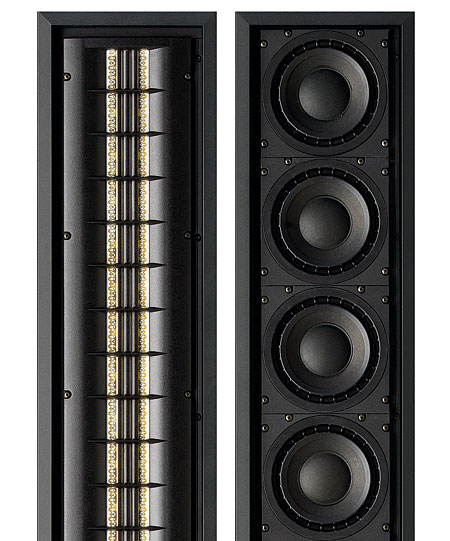
The surround speakers in this 5.1-channel system were a pair of Wisdom’s L75 floorstanding speakers with four woofers and a 48-inch planar magnetic driver array. The L75 is a narrow tower speaker that measures 80 inches in height, including the stands. The common element between all of these speakers in this system and the primary reason you should hear them is Wisdom Audio’s proprietary planar magnetic driver, also known as a PMD. Wisdom Audio, based in Carson City, Nevada, manufactures a wide range of in-room, in-wall, and on-wall speakers based around these drivers.
Although Wisdom Audio employs a proprietary design, a PMD is fundamentally a lightweight, thin film or membrane suspended in a field of powerful magnets. The voice grid snakes across the thin film, similar to the way a car’s rear-window defogger traces back and forth on the glass. In fact, Wisdom Audio claims that the diaphragm is lower in mass than the air that surrounds it, which is said to result in cleaner transient response, enhanced resolution of acoustic details, and a wide dynamic range. When it’s connected to an amplifier, the voice coil interacts with the magnetic field and causes the thin film to move, thus compressing and rarefying air and creating sound. A PMD has the potential for greater dynamic range and long-term reliability than similar-looking, though fundamentally quite different, electrostatic speakers.
The Wisdom Audio planar drivers use neodymium magnets, an alloy of neodymium, iron, and boron. It’s currently the strongest permanent magnet known. Its magnetic properties are so strong that neodymium must be handled carefully in the laboratory to prevent injury. Neodymium is also found in the motors used in electric vehicles.
- Log in or register to post comments



